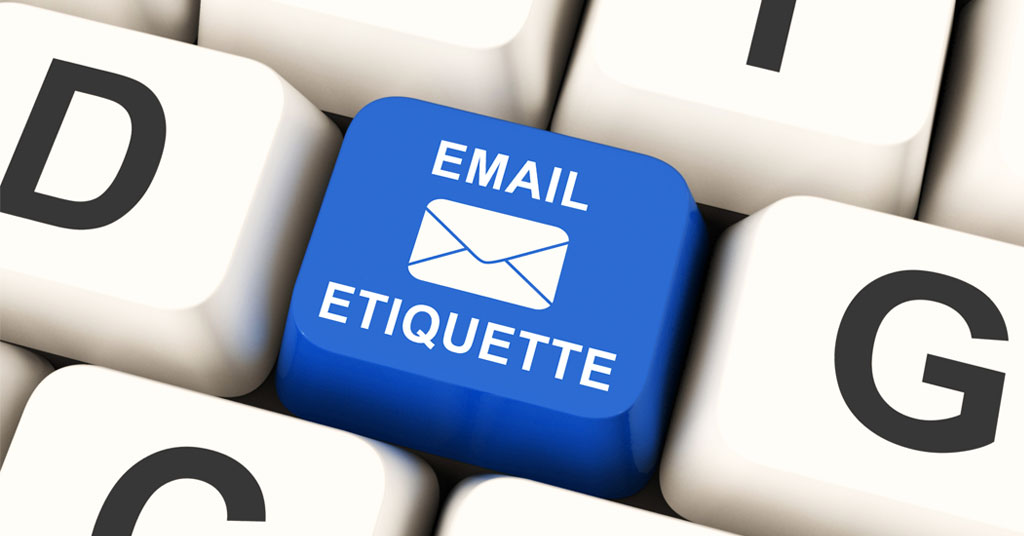In the last couple of decades most of our business communication has been conducted through email. It’s surprising then that most companies don’t train employees on email best practices, namely etiquette. Consequently, many professionals are making up the rules as they go along — not giving email etiquette a second thought, sending out note after unprofessional note.
If you are one of the untrained masses, consider this your primer in email etiquette. For the rest of you, consider this a friendly reminder.
1. Craft your emails intentionally
Mistakes often happen when we write emails too quickly. Be sure the message you want to convey is stated clearly so the audience will have no doubt about what you’ve written. Spellcheck has been known to automatically change words (and therefore meanings), so make sure you carefully proofread the content before hitting send.
2. Use a strong, direct subject line
Subject lines let the audience know what to expect from your email before they open it. Using very clear and direct subject lines such as: Meeting in the Conference Room @ 10:00am, or Following Up on Q3 Report Status, will help determine when or even if your email gets opened.
3. Update subject lines over time
As emails often involve several communications back and forth, the subject of the emails may change through the progression. Be sure to update the subject line to reflect these changes as the email chain evolves.
4. Use “Reply All” judiciously
Most folks don’t appreciate receiving unnecessary emails in their inbox. Be considerate and only reply to all if your response is something everyone needs to know or cares about. Make sure the default setting on your email platform is set to “reply” and not “reply all”. That way you can pause and consider who needs to receive your reply before hitting send.
5. Get to the point
Use as few words as possible to convey your message. Imagine the recipient is even busier than you. (Short, sweet and to the point.)
6. Use embedded links
Whenever possible, provided links that are embedded within the text. They are often quicker and easier to open than attachments.
7. AVOID USING ALL CAPS (Did it feel like I was yelling at you?)
Unless you want to convey extreme anger or excitement, do not use all upper case letters. It’s also harder to read upper case text. Be kind to your audience and use sentence case instead.
8. Use a signature
Adding a signature line to your emails readily provides information that may be useful to the audience. Include your full name, title, company, and phone number(s). Adding the company address and website can also be useful.
9. Be careful with shorthand communication
Using acronyms and abbreviations of common phrases can save time on typing and reading. However, only use these shortcuts if you know for a fact the audience will understand them.
10. Send fewer
Perhaps the most polite thing you can do is to not send an email at all. Make sure emails are necessary and meaningful before sending. If you’re just saying “Thank you”, for example, perhaps you could say “Advanced thanks for your reply” in the original email instead.
11. Address audience respectfully
Unless you know the recipient prefers their nickname, always use the name on their business card or in their email signature. For example, don’t use Andy, when they use Andrew.
12. Check for headline worthiness
Before hitting send, make sure you’re comfortable with the idea of your email content being shared as a newspaper headline. Remember, electronic communications are easily forwarded and leave a trail. Be certain the content of emails you send are appropriate, and won’t cause you any shame, embarrassment, or worse – your job!
13. Use humor cautiously
To be funny, or not to be — that depends on how well you know your audience. If you’re communicating with a colleague whose sense of humor is similar to your own, then sharing the latest joke or using a bit of sarcasm is generally fine. However, if you’re communicating with someone you don’t know well, steering clear of humor is advised.
14. Check for tone
Make sure your message conveys the right tone. Read it out loud before sending. If it sounds angry, snarky, or overly emotional, and you don’t want to convey those tones, it’s likely in need of a rewrite.
15. Avoid a premature send
To make sure you don’t accidentally send an email before you’ve finished composing and proofreading it, establish the habit of adding the recipient’s name just before sending.
What email etiquette lessons do you find beneficial to your professional reputation?
Let us know your thoughts in the comment section below.



